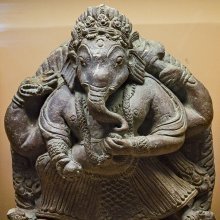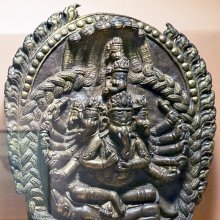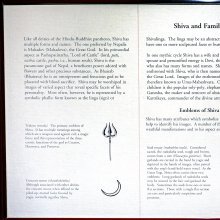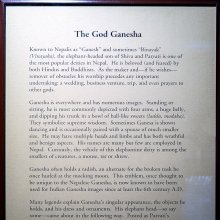Rat, Rāṭ, Raṭ: 15 definitions
Introduction:
Rat means something in Buddhism, Pali, Hinduism, Sanskrit, the history of ancient India, Hindi, biology. If you want to know the exact meaning, history, etymology or English translation of this term then check out the descriptions on this page. Add your comment or reference to a book if you want to contribute to this summary article.
Images (photo gallery)
(+1 more images available)
In Hinduism
Ayurveda (science of life)
Toxicology (Study and Treatment of poison)
Source: Shodhganga: Kasyapa Samhita—Text on Visha ChikitsaThe study of Rats (habitat, bites and treatment) refers to one of the topics dealt with in the Kāśyapa Saṃhitā: an ancient Sanskrit text from the Pāñcarātra tradition dealing with both Tantra and Viṣacikitsā—an important topic from Āyurveda which deals with the study of Toxicology (Viṣavidyā or Sarpavidyā).—The Kāśyapasaṃhitā gives deep insights in respect of different mantras as also the different varieties of snakes alongside with all the attendant details. It also deals in detail with different kinds of rat-bites, bites of twenty kinds of insects like spider, scorpion, centipede, fish and worms and their antidotes and long-term treatment regimen for various venomous bites

Āyurveda (आयुर्वेद, ayurveda) is a branch of Indian science dealing with medicine, herbalism, taxology, anatomy, surgery, alchemy and related topics. Traditional practice of Āyurveda in ancient India dates back to at least the first millenium BC. Literature is commonly written in Sanskrit using various poetic metres.
In Buddhism
Tibetan Buddhism (Vajrayana or tantric Buddhism)
Source: academia.edu: The Structure and Meanings of the Heruka MaṇḍalaThe Rat (animal) is associated with the Yoginī (female deity) named Mūṣī, being situated in the Medinīcakra, according to the 10th century Ḍākārṇava-tantra: one of the last Tibetan Tantric scriptures belonging to the Buddhist Saṃvara tradition consisting of 51 chapters.—Accordingly, the medinīcakra refers to one of the three divisions of the dharma-puṭa (‘dharma layer’), situated in the Herukamaṇḍala. The 36 pairs of Ḍākinīs [viz., Mūṣī] and Vīras are yellow in color; the shapes of their faces are in accordance with their names [e.g., Rat]; they have four arms; they hold a skull bowl, a skull staff, a small drum, and a knife.

Tibetan Buddhism includes schools such as Nyingma, Kadampa, Kagyu and Gelug. Their primary canon of literature is divided in two broad categories: The Kangyur, which consists of Buddha’s words, and the Tengyur, which includes commentaries from various sources. Esotericism and tantra techniques (vajrayāna) are collected indepently.
India history and geography
Source: archive.org: Personal and geographical names in the Gupta inscriptionsRāṭ is the modified form of Rāṣṭra when used in place-names. Rāṣṭra is the oldest and biggest territorial term. In the Ṛgveda and later Saṃhitās, it denotes “kingdom” or “royal territory”. It is considered to be one of the Prakṛtis (constituents) and refers to a country.

The history of India traces the identification of countries, villages, towns and other regions of India, as well as mythology, zoology, royal dynasties, rulers, tribes, local festivities and traditions and regional languages. Ancient India enjoyed religious freedom and encourages the path of Dharma, a concept common to Buddhism, Hinduism, and Jainism.
Biology (plants and animals)
Source: Google Books: CRC World Dictionary (Regional names)Rat in Gambia is the name of a plant defined with Combretum glutinosum in various botanical sources. This page contains potential references in Ayurveda, modern medicine, and other folk traditions or local practices It has the synonym Combretum glutinosum Perr. (among others).
Example references for further research on medicinal uses or toxicity (see latin names for full list):
· Prodromus Systematis Naturalis Regni Vegetabilis (1828)
· Journal of Natural Products (1994)
· Florae Senegambiae Tentamen (1833)
· Journal of Ethnopharmacology (2004)
· Journal of Ethnopharmacology (1999)
· African Journal of Traditional, Complementary and Alternative Medicines (2006)
If you are looking for specific details regarding Rat, for example health benefits, pregnancy safety, extract dosage, diet and recipes, side effects, chemical composition, have a look at these references.

This sections includes definitions from the five kingdoms of living things: Animals, Plants, Fungi, Protists and Monera. It will include both the official binomial nomenclature (scientific names usually in Latin) as well as regional spellings and variants.
Languages of India and abroad
Sanskrit dictionary
Source: DDSA: The practical Sanskrit-English dictionaryRaṭ (रट्).—1 P. (raṭati, raṭita)
1) To shout, scream, yell, cry, roar, howl; घोराश्चाराटिषुः शिवाः (ghorāścārāṭiṣuḥ śivāḥ) Bhaṭṭikāvya 15.27; पपात राक्षसो भूमौ रराट च भयंकरम् (papāta rākṣaso bhūmau rarāṭa ca bhayaṃkaram) 14.81.
2) To call out, proclaim loudly.
3) To shout with joy, applaud.
4) To ring, sound; कर्णे रटन् कटु कथं न वटुर्विषह्यः (karṇe raṭan kaṭu kathaṃ na vaṭurviṣahyaḥ) Mv.3.31.
5) To lament, wail.
6) To crash (as an axe).
Source: Cologne Digital Sanskrit Dictionaries: Shabda-Sagara Sanskrit-English DictionaryRaṭ (रट्).—r. 1st and 10th cl. (raṭati raṭayati) 1. To speak. 2. To shout aloud. 3. To roar. With ā, to call to.
Source: Cologne Digital Sanskrit Dictionaries: Benfey Sanskrit-English DictionaryRaṭ (रट्).—i. 1, [Parasmaipada.] To yell, Mricch. 157, 10; to cry, [Kathāsaritsāgara, (ed. Brockhaus.)] 18, 109. 1. 10, [Parasmaipada.] † To speak (?).
— With the prep. ā ā, To call to, [Śākuntala, (ed. Böhtlingk.)] 55, 5 ([Prakrit]).
Source: Cologne Digital Sanskrit Dictionaries: Cappeller Sanskrit-English DictionaryRaṭ (रट्).—raṭati [participle] raṭita (q.v.) howl, yell, cry, roar. [Intensive] rāraṭīti scream aloud, croak.
Source: Cologne Digital Sanskrit Dictionaries: Monier-Williams Sanskrit-English DictionaryRaṭ (रट्):—[class] 1. [Parasmaipada] ([Dhātupāṭha ix, 10]) raṭati ([perfect tense] rarāṭa; [future] raṭitā etc. [grammar]),
—to howl, shout, roar, yell, cry, [Kāvya literature; Varāha-mihira; Kathāsaritsāgara];
—to crash (as an axe), [Prabodha-candrodaya];
—to ring (as a bell), [Mālatīmādhava];
—to lament, wail, [Hemacandra’s Pariśiṣṭaparvan];
—to proclaim aloud, [Kṛṣṇaj.] :—[Causal] raṭayati ([Aorist] arīraṭat), to howl, shout etc., [Daśakumāra-carita] :—[Intensive] rāraṭīti, to scream aloud, roar, yell, caw etc., [Rāmāyaṇa; Kāśī khaṇḍa, from the skanda-purāṇa; Bhojaprabandha]
Source: Cologne Digital Sanskrit Dictionaries: Yates Sanskrit-English DictionaryRaṭ (रट्):—(ki) raṭati, yati 1. 10. a. To speak.
Source: DDSA: Paia-sadda-mahannavo; a comprehensive Prakrit Hindi dictionary (S)Raṭ (रट्) in the Sanskrit language is related to the Prakrit word: Raḍa.
[Sanskrit to German]
Sanskrit, also spelled संस्कृतम् (saṃskṛtam), is an ancient language of India commonly seen as the grandmother of the Indo-European language family (even English!). Closely allied with Prakrit and Pali, Sanskrit is more exhaustive in both grammar and terms and has the most extensive collection of literature in the world, greatly surpassing its sister-languages Greek and Latin.
Hindi dictionary
Source: DDSA: A practical Hindi-English dictionary1) Rat in Hindi refers in English to:—(nf) constant reception/reiteration..—rat (रट) is alternatively transliterated as Raṭa.
2) Rat in Hindi refers in English to:—(a) attached, loving; used as a suffix to mean engaged in, occupied with (as [karyarata]); (nm) an allomorph of '[rata]' used as the first member in certain compound words; ~[jaga] keeping awake the whole night (to celebrate a happy occasion through singing devotional songs or otherwise)..—rat (रत) is alternatively transliterated as Rata.
...
Nepali dictionary
Source: unoes: Nepali-English DictionaryRat is another spelling for रत [rata].—n. 1. love; infatuation; 2. sexual intercourse; copulation; coitus; adj. 1. dedicated; devoted; engrossed; 2. delighted; attracted to; enchanted; tempted;
Nepali is the primary language of the Nepalese people counting almost 20 million native speakers. The country of Nepal is situated in the Himalaya mountain range to the north of India.
See also (Relevant definitions)
Partial matches: Raat, Rat, Te.
Starts with (+20): Raat, Rata, Rata-bel, Rataba, Ratabandha, Ratabirata, Ratada, Ratadi, Ratagriha, Rataguru, Ratahavis, Ratahavya, Ratahindaka, Ratajala, Ratajvara, Ratakeli, Ratakhinna, Ratakhinne, Ratakila, Ratakride.
Query error!
Full-text (+801): Arat, Mushika, Akhu, Adriraj, Mushaka, Undura, Suraraj, Unduru, Musha, Siddharaja, Ratana, Akhuga, Karva, Vajradanta, Gandhanakula, Indura, Tutuma, Kacigha, Randhrababhru, Gandhakhu.
Relevant text
Search found 175 books and stories containing Rat, Rāṭ, Raṭ, Rats, The rat; (plurals include: Rats, Rāṭs, Raṭs, Ratses, The rats). You can also click to the full overview containing English textual excerpts. Below are direct links for the most relevant articles:
World Journal of Pharmaceutical Research
Effect of Annona senegalensis leaf extract on Wistar rat inflammation. < [2018: Volume 7, June issue 11]
Study on guduchyadi niruha basti for managing parkinsonism. < [2019: Volume 8, October issue 11]
Antihypertensive effect of Dissotis brazzeï root extract in Wistar rats. < [2024: Volume 13, January issue 1]
Parables of Rama (by Swami Rama Tirtha)
Story 254 - Newton's fan < [Chapter LII - Desires]
Story 151 - Thought the index of Man's Nature < [Chapter XXIV - Thought Power]
Story 97 - The True Neighbour < [Chapter XIV - Oneness]
AYU (Journal of Research in Ayurveda)
Beneficial effect of Brahmi Ghrita on learning and memory in normal rat < [Volume 35 (3); 2014 (Jul-Sep)]
Comparative anti-inflammatory and analgesic activities of leaf powder and decoction of Chirabilva [Holoptelea integrifolia (Roxb.) Planch] < [Volume 35 (3); 2014 (Jul-Sep)]
Urolithic property of Varuna (Crataeva nurvala): An experimental study < [Volume 31 (3); 2010 (Jul-Sep)]
Journal of Ayurveda and Integrative Medicine
Neuroprotective effects of Myrica esulenta in Parkinson's model. < [Volume 11 (issue 4), Oct-Dec 2020]
Effect of Phyllanthus emblica, Tinospora cordifolia, and Ocimum on memory in rats. < [Volume 5 (issue 4), Oct-Dec 2014]
Ayurveda antidote Dooshivishari Agada on carboplatin myelosuppression. < [Volume 13 (issue 3), Jul-Sep 2022]
The Malaysian Journal of Medical Sciences
Effects of Dorsal Raphe Inactivation and Stimulation on Morphine CPP < [Volume 22 (issue 2), Mar-Apr 2015]
Cholestasis Effects on Learning and Movement in Bile Duct-Ligated Rats < [v.21(1): 1–76 2014 Jan]
Effects of Diabetes Duration on Behavior in Juvenile Diabetic Rats < [Volume 18 (issue 4), Oct-Dec 2011]
Baliospermum montanum extracts protect against paracetamol hepatotoxicity. < [Volume 33 (issue 4), Apr-Jun 2014]
Anti inflammatory activity of Myrica nagi Linn. Bark < [Volume 30 (issue 4), Apr-Jun 2011]
Anti histaminic activity of cissus quadragularis < [Volume 18 (issue 3-4), Jan-Jun 1999]
Related products






